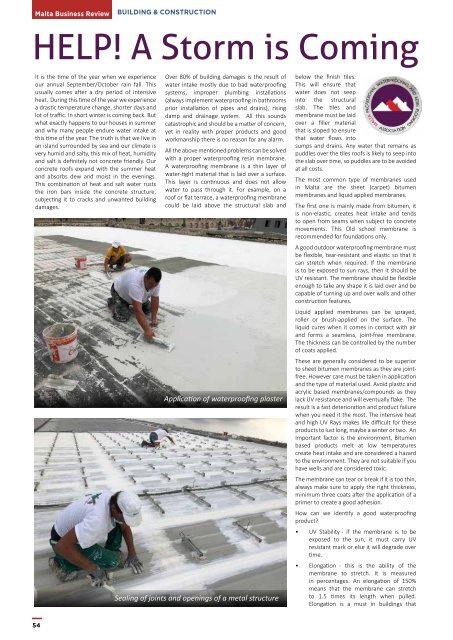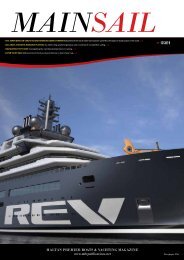MBR ISSUE 44
Create successful ePaper yourself
Turn your PDF publications into a flip-book with our unique Google optimized e-Paper software.
Malta Business Review<br />
BUILDING & CONSTRUCTION<br />
HELP! A Storm is Coming<br />
It is the time of the year when we experience<br />
our annual September/October rain fall. This<br />
usually comes after a dry period of intensive<br />
heat. During this time of the year we experience<br />
a drastic temperature change, shorter days and<br />
lot of traffic. In short winter is coming back. But<br />
what exactly happens to our houses in summer<br />
and why many people endure water intake at<br />
this time of the year. The truth is that we live in<br />
an island surrounded by sea and our climate is<br />
very humid and salty, this mix of heat, humidity<br />
and salt is definitely not concrete friendly. Our<br />
concrete roofs expand with the summer heat<br />
and absorbs dew and moist in the evenings.<br />
This combination of heat and salt water rusts<br />
the iron bars inside the concrete structure,<br />
subjecting it to cracks and unwanted building<br />
damages.<br />
Over 80% of building damages is the result of<br />
water intake mostly due to bad waterproofing<br />
systems, improper plumbing installations<br />
(always implement waterproofing in bathrooms<br />
prior installation of pipes and drains), rising<br />
damp and drainage system. All this sounds<br />
catastrophic and should be a matter of concern,<br />
yet in reality with proper products and good<br />
workmanship there is no reason for any alarm.<br />
All the above mentioned problems can be solved<br />
with a proper waterproofing resin membrane.<br />
A waterproofing membrane is a thin layer of<br />
water-tight material that is laid over a surface.<br />
This layer is continuous and does not allow<br />
water to pass through it. For example, on a<br />
roof or flat terrace, a waterproofing membrane<br />
could be laid above the structural slab and<br />
Application of waterproofing plaster<br />
Sealing of joints and openings of a metal structure<br />
below the finish tiles.<br />
This will ensure that<br />
water does not seep<br />
into the structural<br />
slab. The tiles and<br />
membrane must be laid<br />
over a filler material<br />
that is sloped to ensure<br />
that water flows into<br />
sumps and drains. Any water that remains as<br />
puddles over the tiles roofs is likely to seep into<br />
the slab over time, so puddles are to be avoided<br />
at all costs.<br />
The most common type of membranes used<br />
in Malta are the sheet (carpet) bitumen<br />
membranes and liquid applied membranes.<br />
The first one is mainly made from bitumen, it<br />
is non-elastic, creates heat intake and tends<br />
to open from seams when subject to concrete<br />
movements. This Old school membrane is<br />
recommended for foundations only.<br />
A good outdoor waterproofing membrane must<br />
be flexible, tear-resistant and elastic so that it<br />
can stretch when required. If the membrane<br />
is to be exposed to sun rays, then it should be<br />
UV resistant. The membrane should be flexible<br />
enough to take any shape it is laid over and be<br />
capable of turning up and over walls and other<br />
construction features.<br />
Liquid applied membranes can be sprayed,<br />
roller or brush-applied on the surface. The<br />
liquid cures when it comes in contact with air<br />
and forms a seamless, joint-free membrane.<br />
The thickness can be controlled by the number<br />
of coats applied.<br />
These are generally considered to be superior<br />
to sheet bitumen membranes as they are jointfree.<br />
However care must be taken in application<br />
and the type of material used. Avoid plastic and<br />
acrylic based membranes/compounds as they<br />
lack UV resistance and will eventually flake. The<br />
result is a fast deterioration and product failure<br />
when you need it the most. The intensive heat<br />
and high UV Rays makes life difficult for these<br />
products to lust long, maybe a winter or two. An<br />
Important factor is the environment, Bitumen<br />
based products melt at low temperatures<br />
create heat intake and are considered a hazard<br />
to the environment. They are not suitable if you<br />
have wells and are considered toxic.<br />
The membrane can tear or break if it is too thin,<br />
always make sure to apply the right thickness,<br />
minimum three coats after the application of a<br />
primer to create a good adhesion.<br />
How can we identify a good waterproofing<br />
product?<br />
• UV Stability - if the membrane is to be<br />
exposed to the sun, it must carry UV<br />
resistant mark or else it will degrade over<br />
time.<br />
• Elongation - this is the ability of the<br />
membrane to stretch. It is measured<br />
in percentages. An elongation of 150%<br />
means that the membrane can stretch<br />
to 1.5 times its length when pulled.<br />
Elongation is a must in buildings that<br />
54

















